Recovery Summer 2010
 From Conservapedia
From Conservapedia 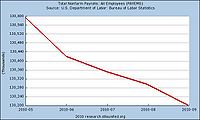
Source:United States Department of Labor, Bureau of Labor Statistics
The Obama administration proclaimed Recovery Summer on June 17, 2010 to spotlight the imapact President Obama's economic program after passage of the American Recovery and Reinvestment Act (or "Stimulus package") by the Democratic controlled 111th Congress in 2009.[1] Vice President Joe Biden was placed in charge of the effort.
During Recovery Summer 393,000 jobs were destroyed according to the Bureau of Labor Statistics,[2] unemployment rose,[3] and economic growth slowed from 5.7% to 1.6%.[4] The number counted by the Department of Labor as unemployed at the start of Recovery Summer was 14,599,000 Americans in July 2010; by September there were 14,767,000 Americans looking for work. 168,000 more unemployed than before President Obama and Vice President Biden announced Recovery Summer had begun.[5]
Contents
- 1 GDP Report showed the Obama Stimulus failed
- 1.1 The Output Gap
- 2 Stimulus edges Unemployment higher
- 3 Housing stimulus falters
- 4 Housing Starts hit record low
- 5 Mortgage delinquency and foreclosures
- 6 Bank failure rate doubled since 2009
- 7 TARP deadbeat list grew to over 120 banks and financial institutions
- 8 'Consumer protection' created higher rate fees for credit card users
- 9 Youth Unemployment hit record high in Obama's first two years
- 10 Unemployed over 50 may never work again
- 11 Durable Goods slump
- 12 Consumer confidence hit new low
- 13 Rererences
GDP Report showed the Obama Stimulus failed[edit]
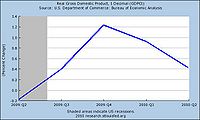
The U.S. Commerce Dept. reported Gross Domestic Product has not responded adequately to the one trillion dollars in stimulus passed since Speaker Nancy Pelosi took control of the U.S. House of Representatives in early 2007. More than 7 million jobs have been lost however, affecting the lives of nearly 30 million Americans. Several trillion dollars have also been added to the National debt.
By contrast, the 3.0%+ growth rates sustained by the Reagan era tax cuts as the United States emerged from the 1982 recession provided the necessary stimulus to maintain a growing population and declining unemployment (second chart at right).
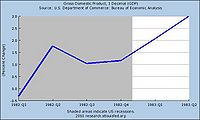
The Congressional Budget Office reported the GDP output gap (the difference between actual GDP and potential GDP if all labor and capital were fully employed) is about 6.5 per cent, and economic growth for the next few years "will probably be muted." The US economy has no recent experience of living with an output gap of anywhere near this level.
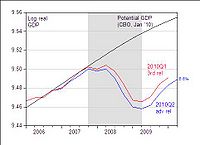
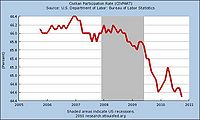
The Output Gap[edit]
The Output Gap is a reflection of actual vs potential output. The U.S. economy was operating 6.5% below its productive capacity. At 1% growth, it would take the better part of a decade to return 10% of the workforce to employment, barring no other unforeseen disasters. The two Stimulus packages, since the Democrats took control of Congress in January 2007, represented an incredible waste of resources which could have been used to foster job creation rather than add to a colossal foreign debt.
The original term Keynesian New Dealers used for the unemployed was "wastage."
Another factor affecting the Output Gap since the Pelosi/Reid Congress took office is the reported decline in Workforce participation.
Workforce participation constitutes the total number of eligible working age adults. Some workers (women who drop out of the workforce for child rearing purposes, or seniors who work to remain active rather because they need the money, for example) in the adult population are dicounted, or deemed 'ineligible' to work to arrive at the base number from which Unemployment number is calculated. Prior to the recession, more than 66% of working age adults were considered to makeup the workforce. Nearly two full percentage points, or 3,000,000 workers have been shaved off the statistics by government number crunchers, to arrive at the base number used to calculated a 9.6% Unemployment figure. If those three million eligible workers were addded back in, the 15,000,000 unemployed figure would swell to 18,000,000 (each one percent unemployment percentage point represents roughly 1.5 million people).
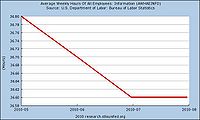
Workers during Recovery Summer were making less money due to a decline in the average number of hours worked per week. Likewise fewer payroll hours does not bode well for the Unemployed, as payroll hours are first to be increased before an employer hires more workers. Declining payroll hours and Workforce participation are two examples of 'under utilization of resources' contributing to the Output Gap.
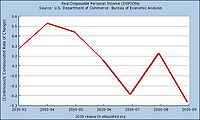
The United States Department of Commerce announced Real Disposable Personal Income[6] declined $16.8 billion in the lasr reporting period of Recovery Summer. Consumer spending which accounts for 70% of all economic activity, job creation, and Unemployment were all affected. One cause was fewer payroll hours.
Further declines in worker takehome also are scheduled to occur after January 1, 2011, when the Obama tax increase is slated to take effect. While campaigning in Dover, New Hampshire, on September 12, 2008 while then candidate Obama made this solemn promise[7] to the American people:
- I can make a firm pledge: under my plan, no family making less than $250,000 will see their taxes increase - not your income taxes, not your payroll taxes.[8]
Stimulus edges Unemployment higher[edit]


The U.S. Labor Department reported Unemployment rose in the Summer of Recovery to 9.6%, or 14,900,000 workers. President Obama called the results "positive"[9] and Wall Street rallied to record levels on the bad news. The New York Times has reported 70 percent of all campaign contributions from Wall Street[10] in 2008 elections went to President Obama and the Democrats.

More than 120 banks and financial institutions who took money from the $700 billion Troubled Assets Relief Program which then Senator Barack Obama voted for have failed to make their scheduled repayments. Five others failed altogether making it unlikely the U.S. Treasury will ever recover the money poured into those institutions. Wall Street banking giants Goldman Sachs, JP Morgan, Citigroup and Morgan Stanley, which received $70 billion in bailout funds, are among the Top 20 largest donors[11] to President Obama's political campaigns.
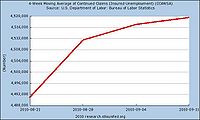


The total number of lives affected by Unemployment since the 110th Congress when the Recession began is well above the constant 15,000,000 unemployed reported. As roughly 2,000,000 newly unemployed enter the jobless ranks monthly, and another 2,000,000 finding jobs are rotated out, the cumulative effect means over 30 million people have directly suffered unemployment.
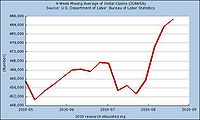
Source: U.S. Dept. of Labor,
Bureau of Labor Statistics.
By September 2010, nineteen months into the Stimulus, the Labor Dept claimed the number of "marginally attached"[12] underemployed (part-time workers seeking full-time work and workers taking employment beneath their skill set) reached over 2,800,000 persons (18.2% of the workforce[13]), up from 2,200,000 in President Obama's first year.
Among the marginally attached, there were 1,200,000 discouraged workers, an increase of 503,000 since Obama's first year in office. Discouraged workers are defined as persons who have lost hope of finding work because they believe no jobs are available.
The length of time a worker is Unemployed was more than twice as long as any time in the last 50 years.
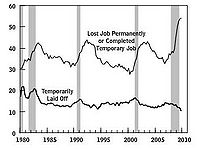
Sources: Congressional Budget Office; Department of Labor, Bureau of Labor Statistics.
Unemployment continued claims soared to 4,519,500 at the end of Recovery Summer. An additional 462,000, first time filers, or an increase of 13,000 displaced workers joined the soup lines in mid October.
An average of 453,250 workers per week, nearly 100,000 per day, were still being laid off 21 months into the Obama Stimulus.
The Congressional Budget Office observed the share of unemployed workers whose previous job was permanently lost was especially pronounced during President Obama's first two years.[14]
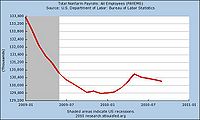
And the workforce continued to shrink.

Housing stimulus falters[edit]
With the aid of the government's program to stimulate and "rescue" housing demand, the National Association of Realtors reported the worst drop in demand on record.
2,100,000 housing construction jobs have been lost since the Pelosi/Reid Democrats captured the Congress in the 2006 mid-term elections.

The "Distressing" gap widened between exisitng home sales and new home sales as the National Association of Homebuilders Confidence Index remains at historic lows. "Builders haven't seen any reason for improved optimism," said a recent NAHB press release.[15]
Housing Starts hit record low[edit]
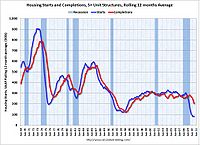
New Home Construction hit a record new low under President Obama's economic program, the lowest level since records have been kept starting in 1969. Housing Construction employment has been the driving force of job creation in leading the way to economic recovery in recent decades. More than 2,000,000 workers were formerly employed in the home construction field prior to the Fannie Mae and Freddie Mac government meltdown of subprime mortgages sparking the economic malaise.
Mortgage delinquency and foreclosures[edit]
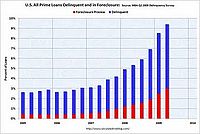

Since the 110th United States Congress took office under Democratic leadership in January 2007, mortgage delinquencies, foreclosures, and repossessions have proceeded on an unrelenting march til they have reached record levels in late Summer, 2010. [2] The Mortgage Bankers Association reported foreclosures have increased 25% in 2010 bringing the total to 2,300,000 homeowners tossed out of their homes.[16]
Bank failure rate doubled since 2009[edit]
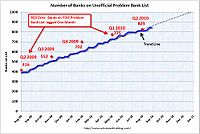
The Federal Deposit Insurance Corporation (FDIC) reported the U.S. Bank failure rate was running at double the number of bank failures in 2009, with twice as many banks on the FDIC's Problem List compared to the previous year, as well.[17] By Septmeber 2010 the Problem List increased to 872 banks in danger of failure and being closed.[18] The banks had assets of $422.4 billion.
TARP deadbeat list grew to over 120 banks and financial institutions[edit]
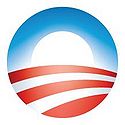
More than 120 banks and financial institutions who took TARP money failed to make their scheduled payments. Five other banks that received money from the $700 billion Troubled Assets Relief Program which then Senator Barack Obama voted for have failed altogether, making it unlikely the U.S. Treasury will ever recover the money poured into those institutions. Goldman Sachs, JP Morgan, Citigroup and Morgan Stanley which received $70 billion in bailout funds are among the largest donors to President Obama's political campaigns.[19][20]
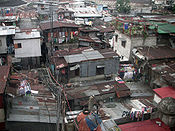
'Consumer protection' created higher rate fees for credit card users[edit]
After signing the Credit Card Accountability, Responsibility, and Disclosure Act in Spring of 2009, President Barack Obama stated,
- ''With this new law, consumers will have the strong and reliable protections they deserve. We will continue to press for reform that is built on transparency, accountability, and mutual responsibility – values fundamental to the new foundation we seek to build for our economy."[23]
Since then credit card interest rates have soared to a nine-year high with the average interest rate jumping to 14.7%, up from 13.1% before the law was passed. This occurred when all other interest rates have been fallen to historic lows.[24] The increase created a dramatic spread of 11.45 percentage points between the average credit card interest rate and the prime rate—the largest margin in 22 years.[25]
President Obama has been a major recipient of campaign contributions from large Wall Street Banks, many of which received TARP bailout funds which then Senator Obama voted for.
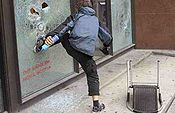
Youth Unemployment hit record high in Obama's first two years[edit]
The Unemployment rate for youths reached a record 19.1 percent in July 2010. According to the US Bureau of Labor Statistics, it was the highest midsummer jobless rate for 16-to-24-year-olds since record keeping began in 1948. The youth unemployment rate has nearly doubled over the past two years, according to the Democracy Now website. A prominent economist from the University of Maryland is warning the US economy could experience painfully slow growth and high unemployment for another decade.
Unemployed over 50 may never work again[edit]

The New York Times has reported older unemployed workers over 50 years of age may never work again in their lifetimes.[26] Of the 15,000,000 who are now unemployed since President Obama took office, 2,200,000 are 55 or older. The unemployment rate in this group is 7.3 percent, an all-time high, and more than double what it was at the beginning of the latest recession. Nearly half of them have been unemployed six months or longer, according to the Labor Department.
In today's job market, because it will take years to absorb the giant pool of unemployed at the pace set by current Washington policymakers, many of these older people may simply quit looking for work and begin an early, impoverished, retirement.
Durable Goods slump[edit]
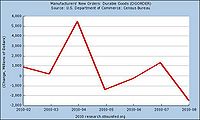
Recovery Summer continued with a drop in demand for U.S. manufactured durable goods. Steep reductions in new orders for airplanes and cars were reported, according to the U.S. Commerce Department. The drop was worst than expected, analysts said.
Transportation equipment orders dropped 10.3% in August. Motor vehicles and parts were also down, falling 4.4%. August capital goods orders were down by 0.9%. Nondefense capital goods, items meant to last 10 years or longer, also dropped 0.9%. Defense-related capital goods orders dropped by 1.5%. Excluding defense, all other durables decreased by 1.2% in August.
Durable goods are defined as manufactured items with a useful life of at least three years. Employment in durable goods manufacturing is vital to economic recovery.
Consumer confidence hit new low[edit]
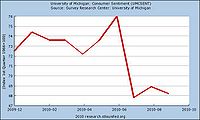
Consumer Confidence continued its downward trek in what the Obama administration proclaimed as Recovery Summer. Consumer Confidence is a key indicator given that hope and expectations play a large part on individual consumer and investors' decisions which have a major impact on the broader economy.
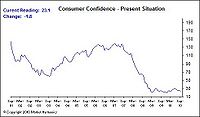
The Conference Board, an independent non-advocacy research association, reported a worse than expected fall in its Consumer Confidence Index to 48.5, the lowest point since February's 46.4. It takes a reading of 90 to indicate a healthy economy — a level not approached since the recession began in December 2007.
Rererences[edit]
- ↑ Administration Kicks Off "Recovery Summer" with Groundbreakings and Events Across the Country, The White House, Office of the Press Secretary, Press Release, June 17, 2010. Retrieved from www.whitehouse.gov October 9, 2010.
- ↑ https://data.bls.gov/PDQ/servlet/SurveyOutputServlet?request_action=wh&graph_name=CE_cesbref1
- ↑ http://research.stlouisfed.org/fred2/graph/?chart_type=bar&s[1][id]=UNRATE
- ↑ http://research.stlouisfed.org/fred2/graph/?chart_type=bar&s[1][id]=GDPC1
- ↑ https://townhall.com/columnists/RichGalen/2010/10/29/relapse_summer
- ↑ https://www.bea.gov/newsreleases/national/pi/pinewsrelease.htm
- ↑ https://www.youtube.com/watch?v=Q8erePM8V5U
- ↑ http://www.realclearpolitics.com/articles/2008/09/obamas_remarks_in_dover_new_ha.html
- ↑ https://www.whitehouse.gov/blog/2010/09/03/president-obama-august-jobs-numbers-positive-news-not-nearly-good-enough Retrieved from whitehouse.gov
- ↑ https://www.nytimes.com/2010/08/31/business/31sorkin.html
- ↑ http://edschultz.invisionzone.com/index.php?showtopic=36796
- ↑ https://www.bls.gov/news.release/empsit.nr0.htm
- ↑ https://townhall.com/columnists/RichGalen/2010/10/29/relapse_summer
- ↑ https://www.cbo.gov/ftpdocs/108xx/doc10871/Chapter2.shtml#1103316
- ↑ http://www.nahb.org/news_details.aspx?sectionID=134&newsID=11318
- ↑ http://www.wtop.com/?nid=111&sid=1863430
- ↑ http://www.ritholtz.com/blog/2010/06/fdic-bank-failure-83/
- ↑ http://www.calculatedriskblog.com/
- ↑ https://www.opensecrets.org/politicians/contrib.php?cid=N00009638&cycle=2008
- ↑ http://www.votesmart.org/finance.php?can_id=9490
- ↑ https://www.census.gov/hhes/www/poverty/data/incpovhlth/2009/pov09fig04.pdf
- ↑ https://www.usatoday.com/news/nation/census/2010-09-16-poverty-rate-income-numbers_N.htm
- ↑ https://www.whitehouse.gov/the_press_office/Fact-Sheet-Reforms-to-Protect-American-Credit-Card-Holders/
- ↑ http://cc.bingj.com/cache.aspx?q=http://www.creditcards.com/credit-card-news/credit-card-rates-chart-1276.php&d=4706378043624044&mkt=en-US&setlang=en-US&w=ff11364,3d68ce3f
- ↑ https://money.cnn.com/2010/08/23/news/economy/credit_cards_synovate/index.htm
- ↑ [1]
| |||||||||||||||||
Categories: [Economic Preparedness] [Obama Administration] [111th United States Congress]
↧ Download as ZWI file | Last modified: 02/19/2023 16:18:10 | 12 views
☰ Source: https://www.conservapedia.com/Recovery_Summer_2010 | License: CC BY-SA 3.0
 ZWI signed:
ZWI signed:
 KSF
KSF